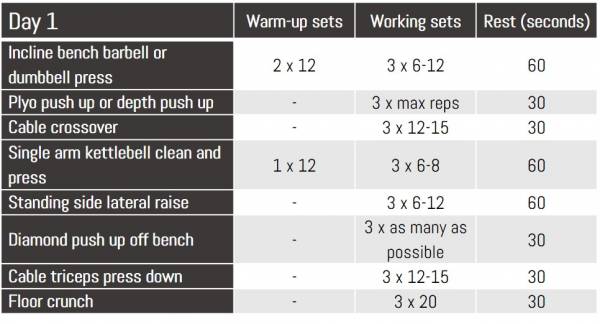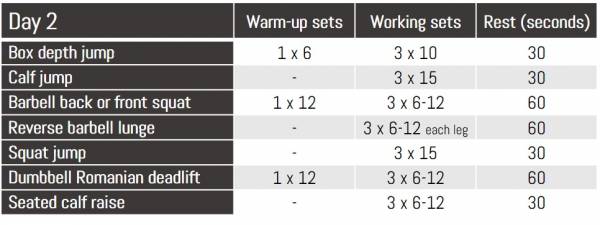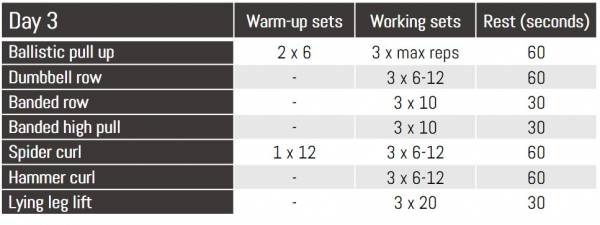What do you think of when you hear the term plyometrics? Do thoughts of CrossFitters, track athletes, or football players doing box jumps, high knees, or bounds come to mind? As a staple tool in an athlete’s training arsenal, plyometric exercise can serve purposes that stretch far beyond just learning to jump higher or cultivate more power. You can effectively include them in your existing hypertrophy program, which will not only enhance your progress, but also add a much-needed new perspective.
What Are Plyometrics?
Plyometric training uses your body’s ability to produce greater force by manipulating the stretch reflex in a particular muscle or muscle group. There are three phases in this force production.
The eccentric phase triggers a stretch of the chosen muscle. Once this phase is underway, the Golgi tendon organ is activated. This receptor is designed to protect the body from overextending a joint. Once activated, it will quickly reverse the movement and begin the concentric contraction of the muscle. Between these two phases (eccentric and concentric) is the amortization phase. This phase harnesses more power and is then applied to the contraction.
In order for you to reap as much reward from this reaction as possible, your movement must be quick and abrupt. Now, this isn’t to be confused with pure power, which is simply speed applied to a resistance, or speed strength. Plyometric movement must include the eccentric portion in order to experience amortization and the subsequent release of increased power.
Overall, plyometric exercises will enhance power and muscle activation, as well as reaction time and athleticism. But if your goals are centered around hypertrophy, do you have room in your routine for such exercise?
Will Plyos Make Me Bigger?
It may not seem obvious whether plyometrics can be integrated into your current program to enhance hypertrophy. But let’s consider few examples. Look at speed skaters’ legs. They are thick with muscle, lean, and incredibly powerful. Speed skating practice is full of plyometric-type movements. Along with a heavy dose of muscular endurance, they also train for hours per day. Speed skaters have to be wary of overtraining, so they certainly aren’t spending much gym time on bodybuilding-style workouts. They train what is necessary, and then spend most of their time on the rink.
The sprinter is another athlete with impressive lower body development. With repeated bouts of plyometric motion, sprinters have legs that rival a bodybuilder, with little or no relative hypertrophy work in the gym.
What about the upper body, you ask? Direct your attention to the gymnast. His upper body is big, shapely, and packed with muscle through, you guessed it, many plyometric-type exercises done on a daily basis. The Olympic rings, pommel horse, and other explosive movements make the gymnast’s upper body as sculpted as a Greek statue.
So can hypertrophy training benefit from the addition of plyometrics? I’ll let you decide, but I think the answer is obvious.
How to Add Plyos to Your Workouts
Let’s take a look at a few examples of some of the more effective plyometric exercises you can utilize for hypertrophy training.
- Lower body: Box jumps, depth jumps, jump squats, jump split squats, straddle hops, bounds, weighted squat jumps, and weighted split squats.
- Upper body: Plyo push ups, uneven push ups, kettlebell swings, ballistic pull ups, banded rows, single arm kettlebell swings, muscle ups and depth push-ups.
How does this all benefit hypertrophy? Fast, ballistic muscle contraction creates more muscle tissue due to the unique stimulus. The dynamic nature of ballistic movements will recruit muscles in different proportions than standard resistance training, hitting some areas you haven’t before. Plyometrics also engage the muscle fibers in a different way, the effects of which may increase cross-sectional area (i.e. visible size) by altering the structure and composition of the fibers themselves.
Plyos also allow you to thrive with a new mode in your training. By applying plyometrics, you essentially throw a curveball into your program. It’s always a good thing when you can flip the script and breathe a little new life into your otherwise dull routine. But let’s not throw the baby out with the bathwater. I’m not suggesting you ditch your current program entirely. Simply adding a few plyo moves into your program will be enough to reap big rewards.
For example, you could tack on a plyometric exercise or two at the tail end of a chest workout. After your bench presses and chest flys, add in some plyo push ups or depth push ups to finish things off. Another way is to start a session with a plyo exercise, such as depth jumps or squat jumps before a set of squats or leg presses. Performing plyometrics prior to any exercise is also a great way to activate more muscle fibers and create a better mind-muscle connection. You can essentially increase athleticism and performance while gaining more muscle.
Sample Plyometric Hypertrophy Program
Below is a sample plyometric program for increased hypertrophy. One quick note before you start: a little goes a long way. It won’t take a ton of plyometric exercises to impact your training, so start slow and have patience. Think of the plyometric additions as enhancers to your current routine, rather than an entire overhaul.
Perform each workout once per week with a full day of rest or active rest in between each day. You could go with Monday, Wednesday, and Friday, or Tuesday, Thursday, and Saturday. On rest days, you can either take off completely, or participate in recreational sports or light daily activity.









